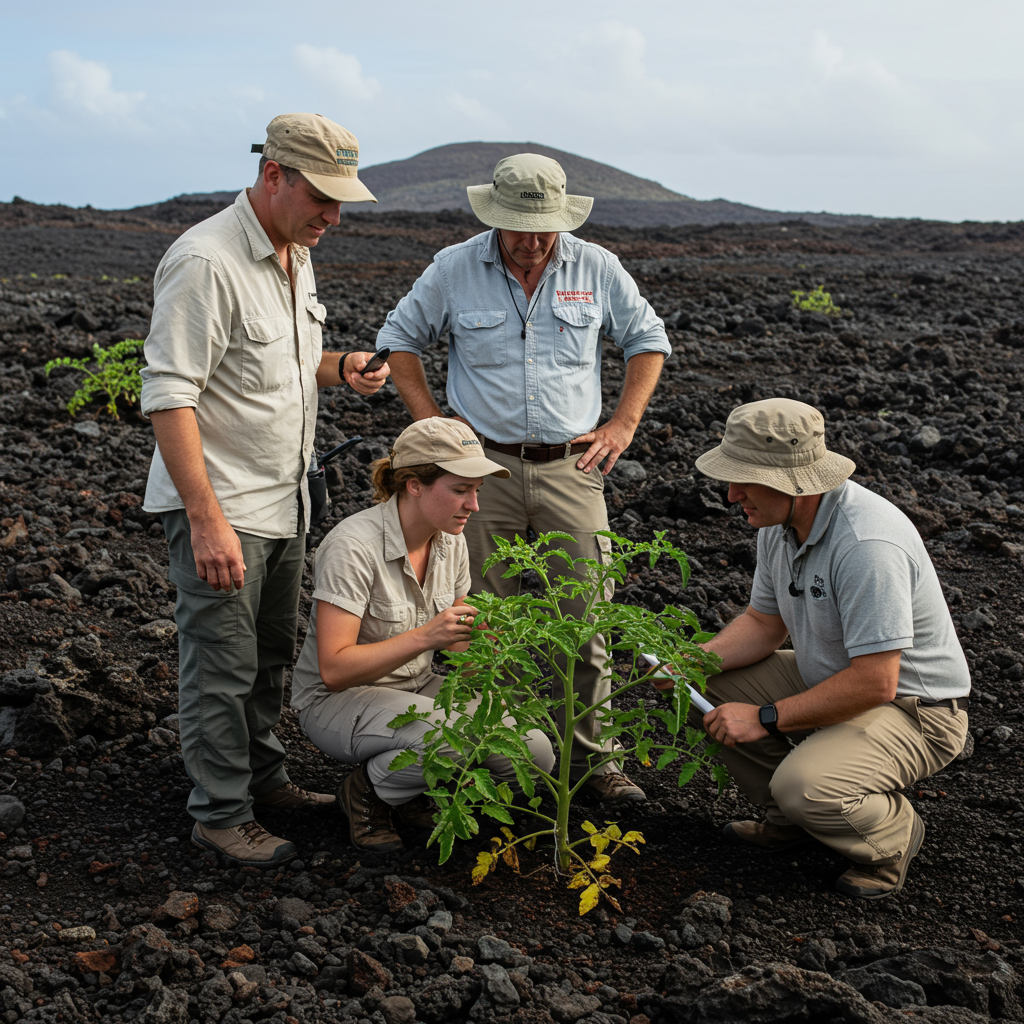The Galápagos islands are famous for showcasing evolution in action, but now scientists are witnessing something truly unexpected: a potential reversal. Wild tomato plants growing on these volcanic islands appear to be reactivating genetic traits dormant for millions of years. This surprising phenomenon involves the revival of ancient, toxic chemical defenses, offering a potential lifeline for the plants facing harsh island conditions. New research suggests these tomatoes are undergoing a kind of evolutionary throwback, discarding recent adaptations to reclaim ancestral characteristics.
Ancient Defenses Re-Emerge in Island Tomatoes
On the younger, rugged western islands of the Galápagos archipelago, wild tomato populations are exhibiting a startling behavior. Instead of maintaining the chemical profiles typical of modern tomatoes, they are producing a complex blend of molecules that harks back to their deep evolutionary past. These compounds, part of a class known as alkaloids, are more commonly associated with ancient relatives like eggplant rather than contemporary tomato varieties.
Alkaloids serve as potent natural pesticides. Plants use these bitter-tasting molecules to protect themselves from insects, fungi, and grazing animals. While the Galápagos environment is often perceived as predator-light, plant life still faces significant defensive pressures.
The Genetics Behind the Throwback
Researchers from the University of California, Riverside, investigated this chemical shift. Their findings, published in Nature Communications, detail how these plants are genetically reverting to produce the older alkaloid forms. The study highlights a remarkable instance of traits resembling those of distant ancestors reappearing through seemingly identical genetic mechanisms.
This observation challenges simplified views of evolution as a strictly one-way process. While the term “reverse evolution” can spark scientific debate, the genetic and chemical evidence in the Galápagos tomatoes is compelling. It suggests that ancient genetic instructions, long suppressed, can be reactivated under specific environmental pressures.
Unpacking the Alkaloid Mechanism
Alkaloids are central to the defense strategies of plants in the nightshade family (Solanaceae), which includes tomatoes, potatoes, and eggplants. Understanding how plants synthesize these compounds is crucial, partly because some alkaloids can be toxic to humans in significant quantities. Controlling their production is a key goal for improving crop safety and pest resistance.
Adam Jozwiak, a molecular biochemist at UC Riverside and lead author of the study, explained their focus. “Our group has been working hard to characterize the steps involved in alkaloid synthesis, so that we can try and control it,” Jozwiak stated in the original discussion. The Galápagos tomatoes provided an unprecedented opportunity to study this process in a wild setting.
The research team analyzed over 30 tomato specimens collected across the islands. They found a stark geographical divide in alkaloid production. Tomatoes from the older, more stable eastern islands produced modern alkaloid types. However, those from the geologically younger, less developed western islands synthesized the ancient, eggplant-like molecules.
The Role of Stereochemistry
This difference in alkaloid form comes down to stereochemistry. Stereochemistry describes the three-dimensional arrangement of atoms within a molecule. Molecules made of the exact same atoms can behave completely differently if their atoms are positioned differently in space. The tomatoes on the western islands were producing a stereochemically distinct variant of the alkaloid molecule. This variant precisely matched the chemical profile predicted for ancient tomato ancestors.
Investigating further, the scientists pinpointed the genetic changes enabling this switch. They discovered that altering just four amino acids in a single enzyme was sufficient to flip the molecule’s structure from the modern form to the ancestral one. To confirm this, they synthesized the modified genes in the lab and introduced them into tobacco plants. These engineered tobacco plants then began producing the older, ancestral tomato compounds.
Environment as a Driving Force
The geographical pattern strongly suggests the environment plays a critical role in driving this evolutionary reversal. The eastern Galápagos Islands are older, more established, and boast greater biological diversity. The western islands, in contrast, are geologically younger, featuring more barren landscapes and less developed soil.
Researchers hypothesize that the harsher conditions on the western islands may favor the ancestral alkaloid form. Jozwiak suggested, “It could be that the ancestral molecule provides better defense in the harsher western conditions.” This implies that ancient traits, once shed, can become advantageous again if the environment changes significantly. It’s a powerful illustration of how selective pressures can influence plant adaptation.
Broader Implications of Evolutionary Flexibility
Modeling techniques using modern DNA helped confirm the direction of this change. These methods allowed scientists to infer the likely traits of long-extinct ancestors. The chemical profile of tomatoes on the younger islands aligned perfectly with these ancestral predictions.
While the concept of “reverse evolution” can be contentious, the clarity and chemical precision observed in these tomatoes make a strong case. Similar reappearances of old traits have been noted in other species, like snakes or bacteria, but rarely with such defined genetic and chemical mechanisms. As Jozwiak put it, “Some people don’t believe in this, but the genetic and chemical evidence points to a return to an ancestral state. The mechanism is there. It happened.”
This study’s findings extend beyond plant science. The principle that ancient genes can reawaken and long-lost traits can re-emerge has significant implications. If simple genetic tweaks can trigger such profound chemical changes in plants, similar flexibility might exist in other organisms. The idea that evolution is more dynamic and potentially reversible than previously thought opens new avenues for understanding biological systems.
This knowledge also holds practical potential. Understanding how plants activate or deactivate specific chemical pathways could inform various fields. It might lead to engineering crops with enhanced natural pest resistance. It could also help reduce naturally occurring toxins in edible produce. Furthermore, unraveling these complex biochemical processes could aid in the design of new medicines or other useful molecules. The Galápagos tomato study serves as a foundational step in understanding nature’s intricate chemical strategies.
Frequently Asked Questions
What kind of ancient traits are Galápagos tomatoes reviving?
Galápagos tomatoes on the younger islands are reviving the production of specific types of toxic compounds called alkaloids. These are natural pesticides. The particular form of alkaloid being produced is chemically similar to those found in ancient relatives of the tomato, like eggplant, rather than the forms typically found in modern tomatoes. This suggests a genetic pathway dormant for millions of years has been reactivated.
Which environmental conditions in the Galápagos are linked to this trait revival?
The revival of ancient alkaloid production is strongly associated with the environmental conditions on the younger, western Galápagos Islands. These islands are geologically less mature than the eastern ones. They feature harsher landscapes, less developed soil, and potentially different ecological pressures. Scientists hypothesize that the ancestral chemical defense may provide better protection against challenges unique to these specific, rugged environments, driving the plants to revert to older traits.
How could studying this trait revival in tomatoes help humans?
Understanding how these tomatoes can turn ancient genetic pathways back on has significant potential benefits for humans. This knowledge could help researchers develop new ways to engineer crops. It might enable creating plants with enhanced natural pest resistance, reducing the need for synthetic pesticides. It could also lead to methods for reducing the levels of naturally occurring toxins, like specific alkaloids, in edible parts of crops, making produce safer for consumption.
Conclusion
The case of the Galápagos tomatoes offers a fascinating glimpse into the surprising flexibility of evolution. Witnessing these plants reactivate ancestral genetic programs and revert to ancient chemical defenses underscores the complex interplay between genes and environment. This study not only expands our understanding of how evolution can proceed but also highlights the potential for biological systems to access a deep reservoir of past adaptations. The insights gained from this unexpected evolutionary turn in island tomatoes could hold valuable lessons for fields ranging from agriculture to medicine, showing that sometimes, the path forward involves reaching back into the past.




